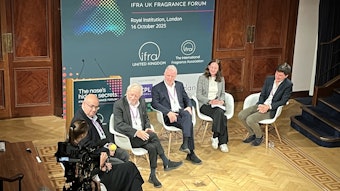The International Fragrance Research Association UK (IFRA UK) reports that a new study from Ruhr University, Bochum researchers shows how humans can detect differences in the smells in various foods through the chemical bonds in the nose. According to the study, different chemicals in specific foodstuffs—such as bananas, mangos and apricots—enable people to be specific about what they are smelling.
The human nose has hundreds of different smell receptors, each one specializing in only one or up to just a few smells. Dr Gelis, a member of the multidisciplinary scientific team who authored the study, explains, “The receptor is like a door lock which can be opened by the right key.” The scientists were the first to shed light on the dynamics of the structure of human sense of smell. There is a characteristic pattern of hydrogen bonds between the source of the smell (the fruit) and the receptors in the nose, and different smell sources activated different parts of the receptors in the nose.
Lisa Hipgrave, director of IFRA UK, says, “The discovery is exciting as previously just how this ‘lock’ was constructed was not understood. Knowing how humans react to different scent triggers could have important implications for perfumers. For instance, malodor neutralizers could be refined to extraordinary effects; and the knowledge could be usefully applied to everything from insect repellents, targeting specific bugs, to relaxation products based on aromas.”
The researchers also point out that smell isn’t unique to the nose. Olfactory receptors occur in other parts of the body too, including sperm and intestines.










